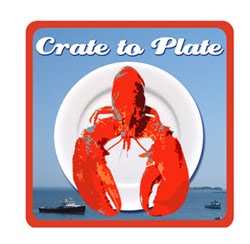 A little behind on your lobster terminology? Here are some lobster terms used by real lobstermen!
A little behind on your lobster terminology? Here are some lobster terms used by real lobstermen!Bug: Slang for lobster.
Cull: A lobster with only 1 claw.
Cock: A male lobster.
Hen: A female lobster.
Berries: Lobster eggs.
Berried Lobster: A hen with eggs under her tail.
V-tail: If a lobsterman catches a berried lobster, he must “v-notch” the lobster. By cutting a small
“v” on the lobster’s tail in the second flipper from the right, the hen safe from being caught for life. Any lobsterman who catches a notched lobster must throw her back even if she is not carrying eggs at the time. This ensures the safety of all procreating females.
Molt: When a lobster sheds its shell in order to grow larger into another shell.
Soft Shell or “Shedder”: A lobster who has recently molted and shed its shell to grow into a larger shell. Soft shell lobsters tend to be a little more inexpensive than hard shell lobsters because there is less meat, but this meat also tends to be sweeter and easier to access by hand.
Hard Shell: A lobster who has fully hardened after molting. Hard shells provide more meat when eating, but are also harder to get into and require nutcrackers.
Cephalothoraxes: This is the name used to describe the fused segments of the head and thorax.
Carapace: The hard shell covering the cephalothoraxes.
Metal Gauge: This is the tool used to measure the lobster before catching. The gauge is placed at the eye socket of the lobster and measures the carapace of the lobster’s shell. If the lobster’s carapace does not fit between the jaws of the gauge, then the lobster must be thrown back.
Shorts: Lobsters who are too small to harvest.
Banding: When a lobster is deemed fit to catch, it must first be banded around its claws. This ensures safety when touching the lobsters, but also protects the lobster from harm to itself and others when in the live-tank.
Live-tank: This is a tank found on a lobster boat full of seawater to hold the day’s catch.
Tote: The box used to hold the bait placed in all traps. Totes can hold up to 200 pounds of bait.
Trap: A cage full of bait used to hold lobsters until they can be caught.
Buoy: A color specific marker used to indicate the placement and ownership of traps. (put in link to buoy blogs)
Gaff: This is a wooden pole with a hook on the end used to pull up buoys from the boat. Pulling up a buoy is called “gaffing”.
Hauler: This is an electronic device on the boat used to haul up traps from the ocean floor. Once the lobsterman has finished “gaffing” the buoy, he runs the buoy rope through the hauler which begins pulling the lobster traps towards the surface.
Sternman: The person responsible for emptying, baiting, and dropping traps after they have been hauled.
Washboard: The railing of the boat where hauled traps are placed to empty and re-bait.



